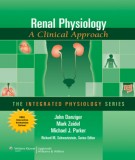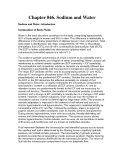
Body fluid compartments
-
Part 1 book "A color handbook - Small animal fluid therapy, acid-base and electrolyte disorders" includes content: Fluid compartments and total body water; techniques and complications of vascular access; components of crystalloid fluids and potential complications of fluid therapy; colloids; canine and feline blood banking and blood product administration.
 103p
103p  muasambanhan03
muasambanhan03
 02-01-2024
02-01-2024
 2
2
 2
2
 Download
Download
-
(BQ) Part 1 of the document Clinical evaluation and management in fluid, electrolyte and acid base disorders has contents: Body fluid compartments, interpretation of urine electrolytes and osmolality, renal handling of nacl and water, disorders of water balance - physiology,... and other contents. Invite you to refer.
 279p
279p  thuongdanguyetan05
thuongdanguyetan05
 05-07-2019
05-07-2019
 34
34
 1
1
 Download
Download
-
(BQ) Part 1 of the document Renal physiology - A clinical approach presents the following contents: Getting started-The approach to renal physiology, the body’s compartments-The distribution of fluid, review questions, clearing waste-glomerular filtration.
 112p
112p  thangnamvoiva3
thangnamvoiva3
 28-06-2016
28-06-2016
 43
43
 2
2
 Download
Download
-
In the past it has been postulated that the metabolism of hump fat could supply water to the fluid compartments when the camel is water deprived. While water is a by-product of carbohydrate and fat metabolism, it is now known that the act of gaining the oxygen required would cause the loss of more water than would be gained. Also, cellular metabolism creates heat and the camel’s survival strategy, especially during periods of water deprivation, is to reduce metabolic rate and hence heat production and water loss.
 165p
165p  conduongdinhmenh
conduongdinhmenh
 07-05-2013
07-05-2013
 43
43
 11
11
 Download
Download
-
Sodium and Water: Introduction Composition of Body Fluids Water is the most abundant constituent in the body, comprising approximately 50% of body weight in women and 60% in men. This difference is attributable to differences in the relative proportions of adipose tissue in men and women. Total body water is distributed in two major compartments: 55–75% is intracellular [intracellular fluid (ICF)], and 25–45% is extracellular [extracellular fluid (ECF)]. The ECF is further subdivided into intravascular (plasma water) and extravascular (interstitial) spaces in a ratio of 1:3.
 35p
35p  socolanong
socolanong
 25-04-2012
25-04-2012
 44
44
 4
4
 Download
Download
-
Harrison's Internal Medicine Chapter 46. Fluid and Electrolyte Disturbances Sodium and Water Sodium and Water: Introduction Composition of Body Fluids Water is the most abundant constituent in the body, comprising approximately 50% of body weight in women and 60% in men. This difference is attributable to differences in the relative proportions of adipose tissue in men and women. Total body water is distributed in two major compartments: 55–75% is intracellular [intracellular fluid (ICF)], and 25–45% is extracellular [extracellular fluid (ECF)].
 5p
5p  ongxaemnumber1
ongxaemnumber1
 29-11-2010
29-11-2010
 83
83
 8
8
 Download
Download
CHỦ ĐỀ BẠN MUỐN TÌM


















